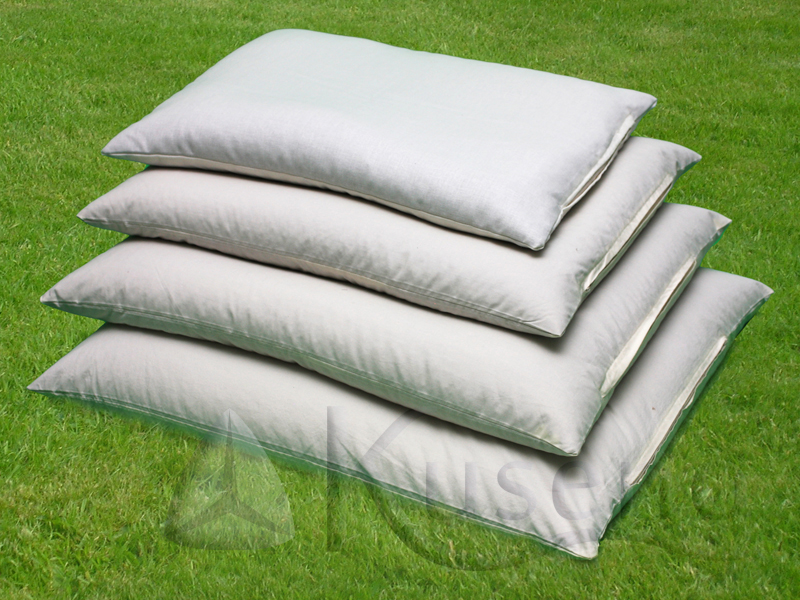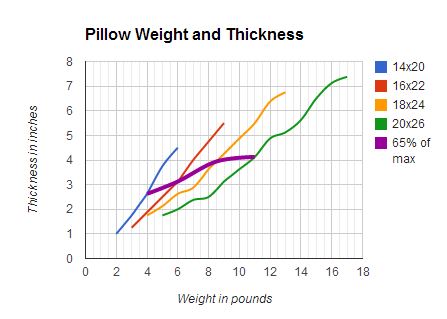 Are they all the same size? No! Where's the fun in that? At Kuseno, we want you to have a choice! We offer four different sizes of Kuseno Buckwheat Hull Pillows, the smallest being 14 x 20 (the standard pillow size in Japan) and the largest being 20 x 26 (the standard pillow size in North America). We also offer two sizes in between, a 16 X 22 and an 18 x 24.
Are they all the same size? No! Where's the fun in that? At Kuseno, we want you to have a choice! We offer four different sizes of Kuseno Buckwheat Hull Pillows, the smallest being 14 x 20 (the standard pillow size in Japan) and the largest being 20 x 26 (the standard pillow size in North America). We also offer two sizes in between, a 16 X 22 and an 18 x 24.
The advantage of a larger sized pillow is that you can put more hulls in it before it is overfull and looks like a balloon. For instance, you can fit a maximum of 6 pounds of hulls in the 14 x 20 and it's 4 1/2 inches tall. And very round. But 6 pounds in the 20 x 26 pillow makes it only 2 inches tall! I've seen the 20 x 26 size pillow sold on other sites with 8 pounds of buckwheat hulls, which makes it about 2.5 inches tall. With this size pillow, the hulls have a lot of room to move around before being stopped by the limits of the fabric and you can wake up with large mountains of hulls on the sides of your head, but very few under your head. For this size, we actually recommend between 10-12 pounds, which makes it between 3 5/8 and 4 7/8 tall. See the page, Is there a special way to use it, for a video on how to adapt a large pillow with not enough fill by folding the fabric under.
 When looking at the height of a Kuseno Buckwheat Hull Pillow, you can't easily compare it to a conventional pillow because a conventional pillow will compress a lot. With a buckwheat pillow, the hulls will move and shift to shape around your head, but they don't compress very much. A properly filled pillow will leave an impression of your head that's less than half an inch deep.
When looking at the height of a Kuseno Buckwheat Hull Pillow, you can't easily compare it to a conventional pillow because a conventional pillow will compress a lot. With a buckwheat pillow, the hulls will move and shift to shape around your head, but they don't compress very much. A properly filled pillow will leave an impression of your head that's less than half an inch deep.
The chart to the right shows all four pillows from too thin to too thick, and the semi-horizontal line is 65% of the maximum thickness.
How do you figure out what thickness you need? I don't know. I haven't figured out that magic formula yet but I do have some suggestions to guide you in the right direction. It depends on how wide your shoulders are, but also how soft your bed is. If you have a pillow-top mattress, your body might sink lower so you need a thinner buckwheat hull pillow, but a firm mattress means you'll need a thicker pillow.
Through extensive research, we have determined recommended fill amounts for each pillow size. It works out to about 60-70% of the maximum amount the pillow will hold but you can certainly order your pillow with less fill or more. You control how much you want to buy, and then you can adjust it further after you use it. I would suggest that you get a half or full pound more hulls than you think you need since you can always take some out.
If you are a side sleeper, you want to think about the distance from your shoulder to your ear and you can judge the right pillow based on your shirt size. If you wear a small to medium shirt, you don't need a very thick pillow and the 14 x 20 pillow would be a great fit. If you wear a medium to extra large shirt, you would be happy with a 16 x 22 pilllow or even the 18 x 24. The 20 x 26 pillow is best suited for people with very broad shoulders.
Back sleepers should choose a thinner pillow, and stomach sleepers almost need no pillow at all or perhaps just something under their hips. If you tend to sleep on all sides, choose a pillow based on how you sleep the majority of the time or get the thicker one for slide sleeping and adjust it for your own personal comfort.

